Written for Criterion’s Current (web site), April 21, 2009. — J.R.
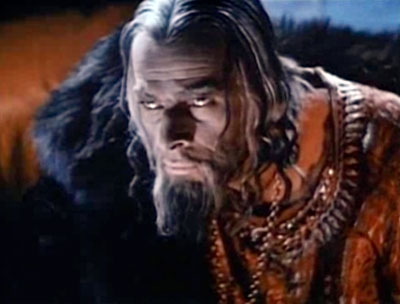
I recently had occasion to show Ivan the Terrible in a course on forties world cinema I’m teaching at Chicago’s School of the Art Institute, and found it more mind-boggling than ever. This has always been the Eisenstein feature that’s given me the most pleasure — the greatest Flash Gordon serial ever made as well as a showcase for the Russian master’s boldest graphics. But ever since I first saw it in the 1960s, this is a pleasure I’ve often had to apologize for, thanks to the vagaries and confusions of cold-war thinking. This thinking maintained that Eisenstein caved into Stalinist pressures, denounced the montage aesthetic that was central to his best work, and turned out an archaic, made-to-order glorification of a dictator.

Part of the problem has been reconciling the film’s multiple paradoxes — how much it functions as Eisenstein’s autocritique and apologia as well as an attack and glorification of Stalin, meanwhile combining elements of both high and low art at virtually every instant with its tortured angles and extreme melodrama. (Though portions of Part II could be termed inferior to Part I, the moment the film switches to color, using Agfa stock seized from the Germans during World War II, it moves into dizzying high gear, reminding us that Walt Disney was one of Eisenstein’s favorite filmmakers.) Read more
Written for The Unquiet American: Transgressive Comedies from the U.S., a catalogue/ collection put together to accompany a film series at the Austrian Filmmuseum and the Viennale in Autumn 2009. — J.R.
RHAPSODY RABBIT (1946)
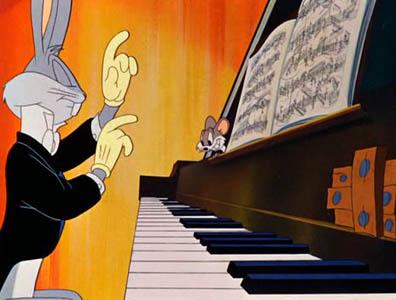
Bugs Bunny, dripping with mannerisms associated with classical music and attempting to perform Liszt’s Second Hungarian Rhapsody at a concert, is interrupted or distracted by problems with his sheet music, coughs from the audience, a carrot break, and a mouse living inside the piano with both a taste for boogie-woogie and a determination to outclass the rabbit and featured performer. James Agee celebrated this 1946 animated short by Friz Freleng at some length, calling it “the funniest thing I have seen since the decline of sociological dancing”: “The best of it goes two ways: one, very observant parody of concert-pianistic affectations, elegantly thought out and synchronized; the other, brutality keyed into the spirit of the music to reach greater subtlety than I have ever seen brutality reach before.”
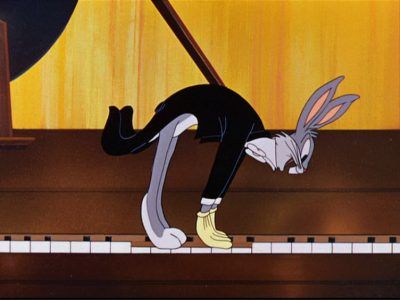
WHAT’S OPERA, DOC? (1957)
Eleven years after Rhapsody Rabbit, in 1957, the joint ingenuity of writer Michael Maltese and director Chuck Jones once again demonstrates how Americans can neither feel entirely comfortable with classical music and opera nor leave it alone, resulting here in a love-hate relationship to Richard Wagner’s Der Ring des Nibelungen featuring Bugs Bunny in drag, a golden-helmeted Elmer Fudd, snatches of ballet and Nuremberg lighting, outlandish sets that exceed any possibilities of stagecraft, and what may well be the strangest assortment of abstract shapes to be found anywhere in Jones’s work. Read more
Written for The Unquiet American: Transgressive Comedies from the
U.S., a catalogue/collection put together to accompany a film series at the
Austrian Filmmuseum and the Viennale in Autumn 2009. — J.R.


WIDE ANGLE SAXON (1976)
This comic short by Owen Land from 1976 could
conceivably be regarded as the Hellzapoppin of the
American experimental film. Just as Hellzapoppin
alludes to the then-contemporary Citizen Kane,
Wide Angle Saxon includes a parody of Hollis
Frampton’s 1971 (nostalgia), called Regrettable Redding
Condescension (alluding to Land’s own 1971 Remedial
Reading Comprehension), which is credited in
turn to one “Al Rutcurts” (i.e., the word «structural»
spelled backwards). But to complicate matters considerably
(if quite obscurely), Land (or George Landow,
as he was known at the time) converted to fundamentalist
Christianity shortly before making this film,
and we are told at the outset that this film’s nominal
hero, “Earl Greaves,” has recently had a religious
conversion as well.

ON THE MARRIAGE BROKER JOKE AS CITED BY SIGMUND FREUD IN WIT AND
ITS RELATION TO THE UNCONSCIOUS, OR CAN THE AVANT-GARDE ARTIST
BE WHOLED? (1979)
Owen Land continues his obscure blend of deconstructive slapstick and
various issues arising from his then-recent conversion to fundamentalist
Christianity in this puzzling if hilarious 17-minute short, during which
a “panderer” in one of the textual interpretations of the Marriage Broker
Joke becomes corrupted into “panda,” and then two men in panda suits
proceed to make a structural film about Japanese salted plums -– or
something like that. Read more
From the August 3, 2001 Chicago Reader. –J.R.
This month the Film Center is inaugurating a monthly “Music Movies” series, five programs that will play on Sundays and Thursdays. The focus in August is jazz films, and the programs include four classics I first saw years ago and four others I’ve just seen for the first time. The worst film in the bunch (Cannonball) happens to be the newest one, and the two most interesting (Cry of Jazz and Black and Tan) are the oldest, though I don’t see any particular trend in this.
It’s difficult to speak of any consistent evolution or devolution in jazz films, because each one is the product of a particular taste and sensibility. One rule I use when evaluating these films is how much we’re allowed to follow the music. Another rule, less obvious and more purist, is how important the on-screen listeners are — which matters a good deal, because jazz at its most exciting is a collective experience involving the audience as well as the interacting musicians. If the people on-screen aren’t seen listening when music is being played, we’re discouraged from listening intently.
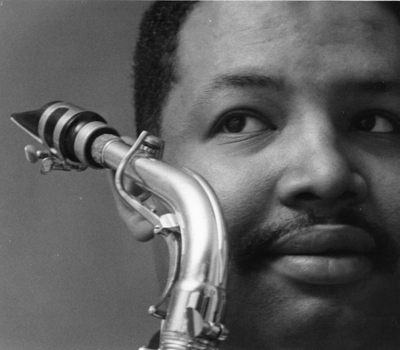
This helps explain why I was driven batty by the new 23-minute video about Cannonball Adderley, a musician who has given me a lot of pleasure. Read more
Written for The Unquiet American: Transgressive Comedies from the U.S., a catalogue/ collection put together to accompany a film series at the Austrian Filmmuseum and the Viennale in Autumn 2009. — J.R.
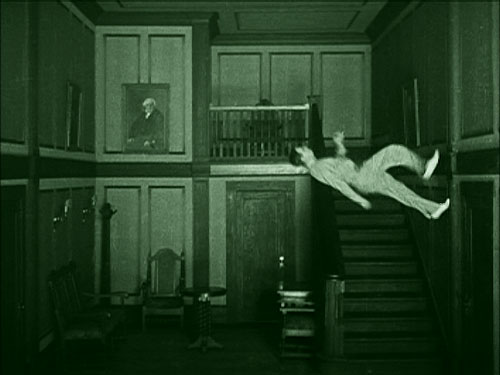
Nominally a rather silly satire about various fads in 1919 America ranging from Ouija boards and diverse superstitions to crackpot psychological experiments, this energetic Douglas Fairbanks comedy -– the first directorial effort of Victor Fleming, Fairbanks’s former cinematographer –- is chiefly a free-form adventure.
Like the projectionist’s dream in Keaton’s Sherlock, Jr., this is basically an occasion for the star’s athletic stunts and choreographic bursts of ardor and enthusiasm, as well as various playful breaches of the ordinary rules of space and time. Most of the latter occurs within an extended dream sequence that virtually opens the film -– set in motion by a sinister secret experiment being conducted by a mad scientist on the wealthy and brash hero, Daniel Boone Brown (Fairbanks) –- but the climactic rain storm and flood at the end, as the film shifts from New York to the countryside, seems almost equally dreamlike and arbitrary.
 Read more
Read more
Written for The Unquiet American: Transgressive Comedies from the U.S., a catalogue/ collection put together to accompany a film series at the Austrian Filmmuseum and the Viennale in Autumn 2009. — J.R.

I was slow to appreciate this masterpiece, which I now regard as Martin Scorsese’s best feature, and I credit Wim Wenders for convincing me that there was far more going on in this movie than I was initially prepared to see. Perhaps the key to this creepy fable about the American obsession with celebrity and media comes in the climactic comic monologue of Rupert Pupkin (Robert De Niro), brimming with self-hatred and shame about his family and his nondescript suburban/ethnic background, which in a way all of the preceding film prepares us for. The script by Paul D. Zimmerman, a onetime film critic at Newsweek, manages to be both non-specific and spot-on about everything that separates the haves from the have-nots -– a subject Scorsese seems to know like the back of his hand, and one made all the more complex by the fact that it’s often hard to separate the privileged from the deprived in this film (a fact spelled out by another troubling climax, the confrontation between Jerry Lewis and Sandra Bernhard). Read more











